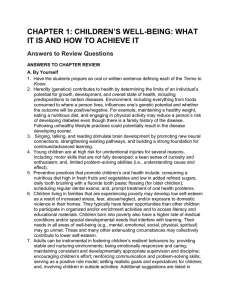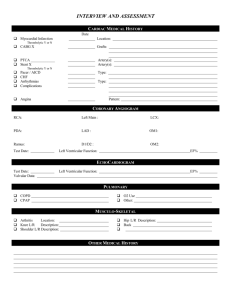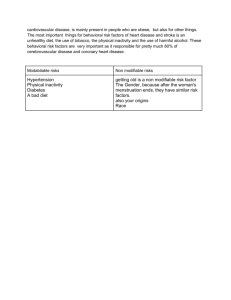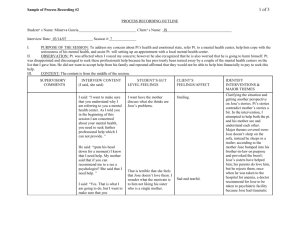edu 153 ch 1 Review Answers
advertisement
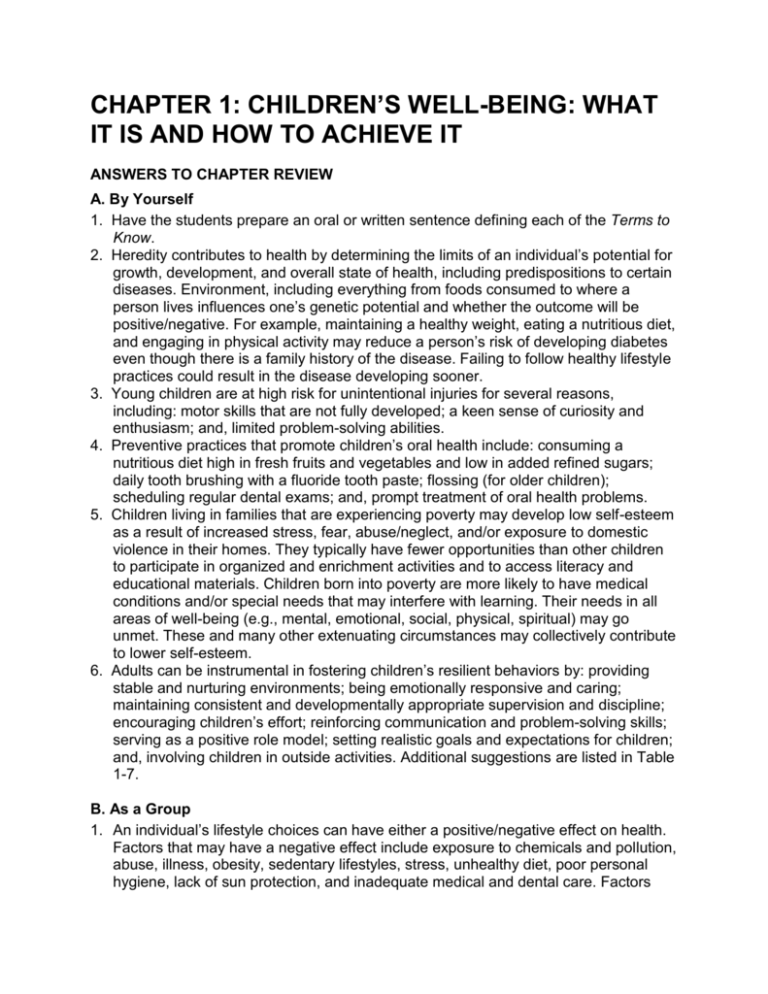
CHAPTER 1: CHILDREN’S WELL-BEING: WHAT IT IS AND HOW TO ACHIEVE IT ANSWERS TO CHAPTER REVIEW A. By Yourself 1. Have the students prepare an oral or written sentence defining each of the Terms to Know. 2. Heredity contributes to health by determining the limits of an individual’s potential for growth, development, and overall state of health, including predispositions to certain diseases. Environment, including everything from foods consumed to where a person lives influences one’s genetic potential and whether the outcome will be positive/negative. For example, maintaining a healthy weight, eating a nutritious diet, and engaging in physical activity may reduce a person’s risk of developing diabetes even though there is a family history of the disease. Failing to follow healthy lifestyle practices could result in the disease developing sooner. 3. Young children are at high risk for unintentional injuries for several reasons, including: motor skills that are not fully developed; a keen sense of curiosity and enthusiasm; and, limited problem-solving abilities. 4. Preventive practices that promote children’s oral health include: consuming a nutritious diet high in fresh fruits and vegetables and low in added refined sugars; daily tooth brushing with a fluoride tooth paste; flossing (for older children); scheduling regular dental exams; and, prompt treatment of oral health problems. 5. Children living in families that are experiencing poverty may develop low self-esteem as a result of increased stress, fear, abuse/neglect, and/or exposure to domestic violence in their homes. They typically have fewer opportunities than other children to participate in organized and enrichment activities and to access literacy and educational materials. Children born into poverty are more likely to have medical conditions and/or special needs that may interfere with learning. Their needs in all areas of well-being (e.g., mental, emotional, social, physical, spiritual) may go unmet. These and many other extenuating circumstances may collectively contribute to lower self-esteem. 6. Adults can be instrumental in fostering children’s resilient behaviors by: providing stable and nurturing environments; being emotionally responsive and caring; maintaining consistent and developmentally appropriate supervision and discipline; encouraging children’s effort; reinforcing communication and problem-solving skills; serving as a positive role model; setting realistic goals and expectations for children; and, involving children in outside activities. Additional suggestions are listed in Table 1-7. B. As a Group 1. An individual’s lifestyle choices can have either a positive/negative effect on health. Factors that may have a negative effect include exposure to chemicals and pollution, abuse, illness, obesity, sedentary lifestyles, stress, unhealthy diet, poor personal hygiene, lack of sun protection, and inadequate medical and dental care. Factors 2. 3. 4. 5. 6. 7. that can have a positive effect on an individual’s health may include a nutrient-rich diet, physical activity, adequate rest, safe and sanitary housing, access to good medical and dental care, stress reduction, wearing seat belts while driving, and positive interpersonal relationships with others. Early childhood teachers can promote children’s wellbeing in several areas: a. protection—including carefully planned environments, daily inspection of equipment and children’s environments for safety hazards, establishment of rules, and the development and enforcement of policies b. services—arranging for screening procedures, early identification of health impairments, conducting daily health observations c. education—providing children with sound information about health, safety, and nutrition, conducting learning experiences that are both planned and spontaneous, and being a positive role model A healthy diet is based on wise food selection and consumption. The availability of foodstuff alone does not necessarily guarantee that an individual will select, eat, and/or practice dietary habits that support well-being Family involvement is essential for establishing consistency (between school/home), keeping families informed about what children are learning, reinforcing families’ efforts, enhancing parenting skills and building trust/respect between school/ home. An important step in building relationships with families involves learning about individual families—their values, beliefs, expectations, interests, etc. When teachers make this effort, they are better able to meet both the family and child’s needs and expectations in a way that is respectful and supportive. Engaging children in vigorous, active play each day promotes their growth and development, mental health, and weight management. Research has also demonstrated a reduction in stress and behavior problems when children are given opportunities to release excess energy through physical activity. Movement activities can be integrated with reading, math, and science lessons. For example, a science lesson might involve having children demonstrate how various animals move; or, children might illustrate the answers to simple math problems: “Jump up and down to show me the answer to 1+1=2”. Children can also be instructed to hop or skip to lunch or to the bathroom or when accompanying the teacher on an errand. Five minute stretch or jumping jack breaks can also be taken every hour. There are many other creative ways to make daily aerobic (increase in heart and breathing rates) activity fun for children and adults! Self-concept is the self-image a person forms based on feedback – the ways in which you are treated by others, how others respond to you, and what others may or may not say about you. The classroom environment, and the ways in which teachers interact with children also shapes self concept. For example, teachers can have a positive effect when they encourage and acknowledge children’s efforts, set realistic goals and expectations, accept children’s mistakes and limitations, and support their individuality. However, they can also exert a negative effect on children’s selfconcept by criticizing or failing to recognize their efforts or products, setting unrealistic goals that are likely to set children up for failure, and not giving children their time and attention. A teachers’ state of mental health can have a definite effect on the classroom tone (climate) and nature of all interactions with children, families, and colleagues. In addition, children’s safety may be at risk if a teacher is preoccupied or distracted by personal problems. A positive state of mental health is essential if a teacher is to be understanding, respectful, caring, and nurturing. ANSWERS TO CASE STUDY 1. On a short-term basis, Jose’s health is being challenged by a sedentary lifestyle, boredom, stress, and fear associated with staying home alone. His long-term outlook is also poor due to inactivity, a diet high in fat and salt, and potential weight gain. 2. Jose is at some risk because he arrives home and stays alone for several hours each day. 3. Jose faces a high risk of developing a number of chronic diseases, including obesity, cardiovascular heart disease, high blood pressure, diabetes, and certain forms of cancer. 4. Environmental risks contributing to Jose’s health may include lack of opportunities for physical activity and unhealthy dietary choices. 5. Jose’s mother needs assistance in locating child care so that he is not left at home alone. Jose’s mother needs nutritional guidance, and learn how to prepare healthier meals. Jose must be encouraged to begin participating in some form of active play or exercise each day.
